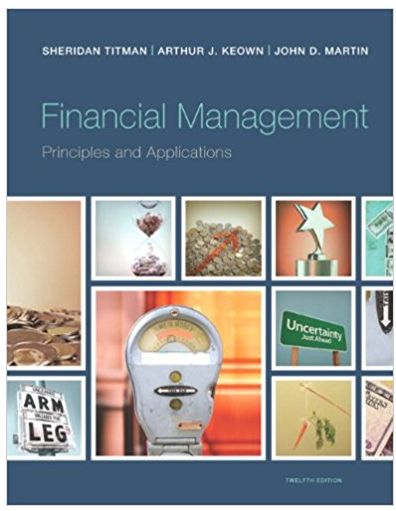5.Suppose your firm is considering investing in a project with the cash flows shown as follows, that the required rate of return on projects of
5.Suppose your firm is considering investing in a project with the cash flows shown as follows, that the required rate of return on projects of this risk class is 8 percent, and that the maximum allowable payback and discounted payback statistic for the project are three and three and a half years, respectively.
Time 0 1 2 3 4 5
Cash Flow -100,000 30,000 45,000 55,000 30,000 10,000
.Use the IRR decision rule to evaluate this project; should it be accepted or rejected? Calculate the IRR
6 . Suppose your firm is considering investing in a project with the cash flows shown as follows, that the required rate of return on projects of this risk class is 8 percent, and that the maximum allowable payback and discounted payback statistic for the project are three and three and a half years, respectively.
Time 0/ 1 /2 /3 /4 /5
cash flow -100,000 / 30,000 / 45,000 / 55,000 / 30,000 / 10,000
Use the NPV decision rule to evaluate this project; should it be accepted or rejected?Calculate the NPV
7.
Suppose your firm is considering investing in a project with the cash flows shown as follows, that the required rate of return on projects of this risk class is 8 percent, and that the maximum allowable payback and discounted payback statistic for the project are two and two and a half years, respectively.
Time 0/ 1/ 2/ 3/ 4/ 5
Cash flow -125,000 / 65,000 / 78,000 / 105,000 / 25,000
Use the NPV decision rule to evaluate this project; should it be accepted or rejected? Calculate the NPV
8.Suppose your firm is considering two mutually exclusive, required projects with the cash flows shown as follows. The required rate of return on projects of both of their risk class is 10 percent, and the maximum allowable payback and discounted payback statistic for the projects are two and a half and three and a half years, respectively.
time 0 / 1 / 2 /3
Project A Cash flow -1,000 / 300 / 400 / 700
Project B Cash flow -500 / 200 / 400 / 300
Use the payback decision rule to evaluate these projects; which one(s) should be accepted or rejected?
9.Suppose your firm is considering two mutually exclusive, required projects with the cash flows shown as follows. The required rate of return on projects of both of their risk class is 8 percent, and the maximum allowable payback and discounted payback statistic for the projects are two and three years, respectively.
Time 0 / 1 /2 /3
Project A Cash Flow -20,000 / 10,000 / 30,000 / 1,000
Project B Cash Flow -30,000 / 10,000 / 20,000 / 50,000
Use the NPV decision rule to evaluate these projects; which one(s) should be accepted or rejected?
10.Suppose your firm is considering investing in a project with the cash flows shown as follows, that the required rate of return on projects of this risk class is 8 percent, and that the maximum allowable payback and discounted payback statistics for the project are three and a half four and a half years, respectively. Use the payback decision to evaluate this project; should it be accepted or rejected?What is the payback period?
time 0 / 1 /2 /3 /4 /5 / 6
Cash Flow -5000 / 1300 / 1400 / 1600 / 1600 / 1100 / 2000
11.Use the information below to:
A.Calculate the firms breakeven point in units?
B.Draw a breakeven chart for this firm.
FC = 20
P = 2
VC = .80
Step by Step Solution
There are 3 Steps involved in it
Step: 1

See step-by-step solutions with expert insights and AI powered tools for academic success
Step: 2

Step: 3

Ace Your Homework with AI
Get the answers you need in no time with our AI-driven, step-by-step assistance
Get Started


